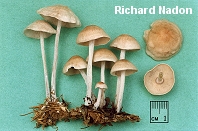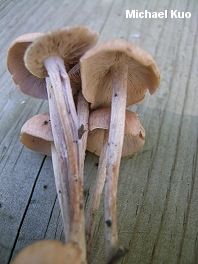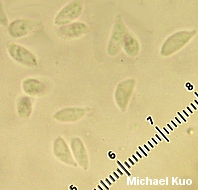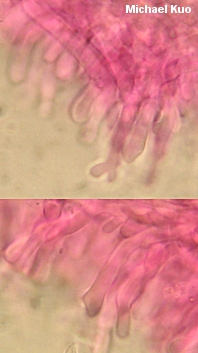| Major Groups > Gilled Mushrooms > Pale-Spored > Collybioid > Gymnopus confluens |

|
Gymnopus confluens [ Basidiomycetes > Agaricales > Marasmiaceae > Gymnopus . . . ] by Michael Kuo Gymnopus confluens is a decomposer of both hardwood and conifer litter, recognized by its crowded gills, quickly fading cap, tendency to grow in loose clusters, and its distinctive stem, which is covered with a fine whitish fuzz and is quite long in proportion to the width of the cap. There may be several North American species going under the name Gymnopus confluens (which officially represents a European species); it is reported from vastly different ecosystems--from forests of towering conifers in the Pacific Northwest to aspen forests in the Rocky Mountains to oak-hickory forests in eastern North America--and authors often note collections with fairly substantial morphological differences (e.g. Mitchel & Smith, 1978; Arora, 1986). Collybia confluens is a synonym. Description: Ecology: Saprobic; growing in loose clusters or sometimes merely gregariously on leaf or needle litter or from woody debris; summer and fall; apparently widely distributed in North America, at least as a species group (see comments above). Cap: 1-6 cm; convex with an incurved margin when young, becoming broadly convex, bell-shaped, or nearly flat; moist or dry; bald or minutely silky; reddish brown at first, but quickly fading to pale tan or pinkish buff. Gills: Narrowly attached to the stem, or nearly free from it by maturity; crowded or close; whitish when young, darkening to pinkish buff. Stem: 2.5-13 cm long; 2-9 mm thick; more or less equal, or flared at the apex and/or base; dry; tough and flexible; finely hairy or finely velvety with whitish fuzz that becomes more noticeable as the mushroom matures; buff to pale cinnamon. Flesh: Whitish; thin; tough. Odor and Taste: Not distinctive, or very rarely reminiscent of onions. Chemical Reactions: KOH negative to faintly olive on cap surface. Spore Print: Creamy white. Microscopic Features: Spores: 6-10 x 3.5-5 µ; smooth; lacrymoid to elliptical or nearly fusoid; inamyloid (but reported as amyloid on young specimens from Colorado by Mitchel & Smith, 1978). Pleurocystidia absent. Cheilocystidia abundant and easily demonstrated; clavate, subclavate, cylindric, or subfusoid; flexuous; often somewhat lobed and/or diverticulate; to about 70 x 6 µ. Pileipellis a cutis of branched elements 2.5-7 µ wide. REFERENCES: (Persoon, 1796) Antonín, Halling & Noordeloos, 1997. (Fries, 1821; Saccardo, 1887; Kauffman, 1918; Coker & Beardslee, 1921; Mitchel & Smith, 1978; Smith, Smith & Weber, 1979; Halling, 1983; Arora, 1986; Phillips, 1991/2005; Lincoff, 1992; Barron, 1999; Roody, 2003; Halling, 2004; McNeil, 2006; Miller & Miller, 2006; Trudell & Ammirati, 2009.) Herb. Kuo 09060801. This website contains no information about the edibility or toxicity of mushrooms. |
© MushroomExpert.Com |
|
Cite this page as: Kuo, M. (2013, February). Gymnopus confluens. Retrieved from the MushroomExpert.Com Web site: http://www.mushroomexpert.com/gymnopus_confluens.html |



